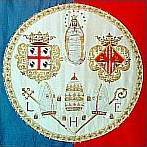Molecular
analysis of beta-thalassemia carriers with intact beta-globin gene
This is a collaborative research
involving researchers from University of Cagliari, ASL N°8 of Cagliari
and IRTAM, CNR of Cagliari.
The research laboratories of this University are carrying out prevalently
studies on beta-globin gene disease (Thalassemia), and hemoglobinopathies.
The beta-thalassemias are very heterogeneous at the molecular level.
At the present time approximately more than 100 different molecular
defects have been characterized. These defects consist mostly in single
nucleotide substitutions, small addition or deletions. Less frequently
beta-thalassemia results from a gross structural rearrangement of the
DNA.
On the contrary, alfa-thalassemia
are usually caused by the mechanism of gene deletion. Restriction endonuclease
digestion, non-denaturing gradient gel electrophoresis, and allele specific
oligonucleotide probes or allele specific oligonucleotide primers may
define known mutations.
Unknown mutations are detected by denaturing gradient gel electrophoresis
followed by direct sequencing.

Other potentially useful
methods for unknown mutations are single strand conformation polymorphism
analysis and chemical mismatch cleavage analysis. Beta-thalassemia genes
are concentrated in peoples residing in regions of the world endemic
of malaria, including Mediterraneans, North Africans and Middle Easterners,
Asian Indians, Chinese and Southeast Asians, and black Africans. The
large majority of heterozygous for beta-thalassemia, showing the classical
phenotype, carry a mutation in the globin gene.
A few exceptional cases have been described, in whom in spite of the
presence of beta-thalassemia-like hematological features, neither defects
in the beta-globin gene nor deletions in the beta-globin gene cluster
were found.
It was postulated that the
erythroid Kruppel-like factor (EKLF) could play an important role in
determining this phenotype. EKLF is a zinc finger, which binds the CACCC
consensus sequence in the beta-globin gene promoter.
Mutations in the CACCC box abolish the EKLF binding. With the aim of
investigating the involvement of EKLF in a fraction of thalassemia syndromes
in which the defect appeared to be inherited unlinked to the beta-globin
gene cluster, the group involved in this research sought up to clone
and characterize the human EKLF gene.
Both complementary DNA and genomic DNA were cloned and entirely sequenced.
No nucleotide variation was detected in those patients with normal beta-globin
gene sequences.
These results give evidence that neither the entire beta-globin cluster
nor the EKLF gene are involved in the pathogenesis of these determinants.
| Universities
involved in this project: |
 University
of Cagliari - Italy University
of Cagliari - Italy |
 |
|
Prof. Maria Cristina Rosatelli
Prof. Antonio Cao
Dr. Paolo Moi - ASL N° 8-Cagliari
(Local Sanitary Company N°8- Cagliari)
Dr. Valeria Faa - IRTAM, CNR Cagliari (Regional Institute Thalassemia
and Mediterranean Anemias, National Research Council Cagliari)
|
Copyright © 2000 -
University of Cagliari (Italy) - All right reserved


